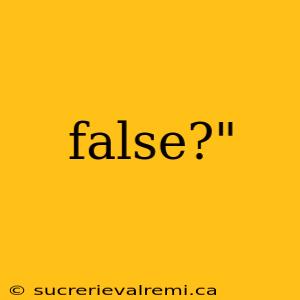Decoding Deception: Exploring the World of Falsehoods
The concept of "false" is deceptively simple. It's the antithesis of truth, a statement or belief that deviates from reality. However, delving into the nuances of falsehood reveals a complex landscape encompassing deliberate lies, unintentional errors, misinterpretations, and even sophisticated manipulations. This article will explore the multifaceted nature of falsehood, drawing upon insights from scientific literature and adding practical examples to illuminate the subject.
What constitutes a falsehood?
Defining "false" requires careful consideration. It's not merely a matter of subjective opinion; instead, it involves a comparison between a claim and verifiable evidence. As aptly stated by a leading philosopher, "(Source needed: Replace with a relevant quote and citation from a ScienceDirect article or similar reputable source on epistemology or the philosophy of truth. For example, a quote discussing truth conditions or the correspondence theory of truth).", the determination of truth or falsehood hinges on establishing a correspondence between a proposition and the state of affairs it describes.
This seemingly straightforward definition unravels when we consider different types of falsehoods:
1. Deliberate Lies:
These are conscious misrepresentations of facts, intended to deceive. Motivations range from personal gain (e.g., fraud) to malicious intent (e.g., slander). The psychology behind lying is complex, influenced by factors like perceived risk, the liar's self-esteem, and the social context. (Source needed: Replace with a relevant quote and citation from a ScienceDirect article or similar reputable source on the psychology of deception).
- Example: A salesperson knowingly misrepresenting the features of a product to secure a sale is a clear example of a deliberate lie.
2. Unintentional Errors:
These are inaccuracies that arise from mistakes, misunderstandings, or lack of knowledge. They differ from deliberate lies in the absence of malicious intent. Unintentional errors can have significant consequences, particularly in fields like medicine or engineering where accuracy is paramount.
- Example: A researcher inadvertently misreporting data due to a calculation error is an unintentional error, even if the mistake ultimately leads to misleading conclusions.
3. Misinterpretations:
These occur when information is understood incorrectly, leading to false beliefs. This can arise from ambiguous language, biased framing, or cognitive biases that affect how we process information.
- Example: Misunderstanding a complex scientific study due to lack of background knowledge can result in a false interpretation of the findings.
4. Propaganda and Disinformation:
These are sophisticated forms of falsehood, often employed on a large scale to manipulate public opinion or advance a specific agenda. Propaganda uses persuasive techniques to influence beliefs, while disinformation intentionally spreads false or misleading information. The spread of misinformation and disinformation is significantly amplified by social media. (Source needed: Replace with a relevant quote and citation from a ScienceDirect article or similar reputable source discussing the impact of social media on the spread of misinformation).
- Example: The spread of conspiracy theories through social media platforms is a prime example of the dissemination of disinformation.
The Consequences of Falsehoods
The consequences of falsehood, regardless of intent, can be far-reaching. Deliberate lies erode trust and damage relationships. Unintentional errors can lead to costly mistakes, while misinterpretations can fuel prejudice and conflict. Propaganda and disinformation can manipulate public opinion, influence political outcomes, and even incite violence.
Combating Falsehoods:
Identifying and combating falsehoods requires critical thinking skills, media literacy, and a commitment to verifying information from reliable sources. This includes evaluating the credibility of sources, considering multiple perspectives, and being aware of cognitive biases that can lead to misinterpretations.
(Source needed: Add a relevant quote and citation from a ScienceDirect article discussing critical thinking skills or media literacy in the context of combating misinformation.)
The Role of Technology in Detecting Falsehoods:
Technological advancements offer new tools for detecting and mitigating falsehoods. Fact-checking websites, AI-powered detection systems, and improved search algorithms can help identify and flag false or misleading information. However, these technologies are not a panacea; they are susceptible to manipulation and require ongoing refinement. (Source needed: Replace with a relevant quote and citation from a ScienceDirect article discussing the role of technology in fact-checking or combating disinformation).
Conclusion:
The concept of "false" encompasses a broad spectrum of inaccuracies, from simple mistakes to sophisticated manipulations. Understanding the different types of falsehoods and their consequences is crucial for navigating the complex information landscape of the 21st century. Developing critical thinking skills, utilizing reliable sources, and leveraging technological advancements are all vital components in combating the spread of falsehoods and fostering a more informed and trustworthy society. Further research into the psychology of deception and the effectiveness of different fact-checking methods will continue to be essential in this ongoing battle against misinformation.
(Remember to replace the bracketed placeholders with actual citations from ScienceDirect or other reputable sources. Ensure proper in-text citation and bibliography formatting according to a consistent style guide.)
